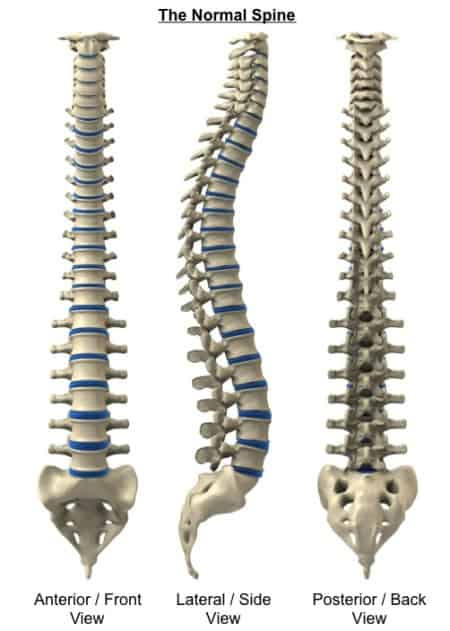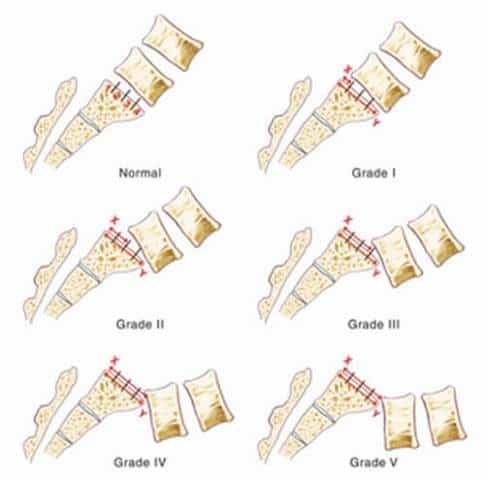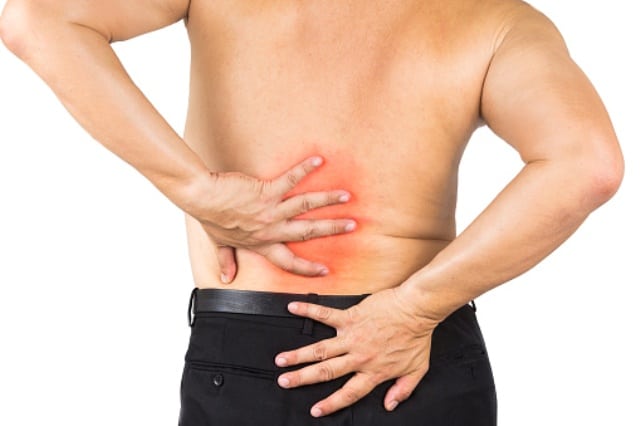You might have seen old people complaining about the pain in their back. It might be due to anterolisthesis. It is mostly due to weakened bones. As the growing age, bones keep losing calcium.
If you don’t try to keep your bones healthy, it can cause some serious problems and might even lead to surgery.
Let’s know about the common problem in the following article.
Table of Contents
Anatomy Of Spine

If you want to understand Anterolisthesis, you need to understand the anatomy of the spine. Then only you can understand how Anterolisthesis affects your overall health. Starting from the basic, we know that spine is made of 33 individual bones that are stacked one on top of the other.
The Spinal column is very important as it gives the body support and protects the spinal cord from any injury.
Our body is a fine piece of art and the vertebrae is a perfect example of it. The way vertebrae are put together, it provides enough space for the nerves to be connected to other parts of the body for proper functioning.
The spinal column is divided into regions, each having its specific functions. Looking from the side, the length of the spine takes an S-shaped curve.
This provides balance and protection. It helps us perform a range of motions and also absorbs shock.
So, if any damage is done to the vertebrae, it will also affect the nerve functioning of the body part that is being connected by that specific nerve.
Anterolisthesis Vs Spondylolisthesis
Sometimes, a crack develops in one of the vertebrae and it leads to the development of a stress fracture. This fracture does not heal like a normal bone because of the constant stress the lower back experiences.
This type of fracture is known as Spondylolysis. Sometimes, this cracked vertebrae slips from its original position.
Spondylolisthesis is a general term that defines the condition of the spine caused by the displacement of either forward or backward slippage. This leads to spine deformity and nerve root compression.
Anterolisthesis is a type of Spondylolisthesis.
In Anterolisthesis, the vertebra slips forward. Both are responsible for nerve root compression and if left untreated might result in spinal deformity.
Anterolisthesis is derived from two words, ante and listhesis. Ante means front and listhesis means slippage.
So, as the name suggests Anterolisthesis occurs when there is a forward slip of the spine. It is a very common problem in the human body.
Grades Of Anterolisthesis

Anterolisthesis is measured with separate grades depending on the criticality and the damaging amount of the human body. The grades are defined according to the slipping amount.
As there is an increase in the grades, the problem becomes more chronic. Basically, higher the grade, more serious is the problem.
Here are the different grades with slipping percentage of the vertebral body:
Grade I
It is the low-intensity Anterolisthesis in the human body. The percentage of slipping forward of the vertebral body is less than 25%.
Grade II
In this grade, the slipping percentage is between 25% and 50%. It should be taken seriously.
Grade III
For grade III Anterolisthesis, the slipping percentage is between 50% and 75%.
Grade IV
The slipping percentage becomes more than 75%. It is considered as a serious case of Anterolisthesis.
Grade V
It is the last grade. In this, the vertebra completely falls off.
Causes Of Anterolisthesis
Anterolisthesis is caused by external factors. There are many reasons for the spinal cord problem. The breakdown is mainly due to impact subjected on the spinal cord and the vertebrae. The most common reason for this impact is accident or injury.
The other reasons include:
- Falling from heights.
- Bullet wound.
- Injury from sports or any other strenuous activities.
- Poor posture.
- A defect in the vertebra.
- Degeneration of cartilage.
- Repetitive trauma to the vertebra from overexertion of the spine.
- The growth of tumor in the spinal region.
- The weakness of bones of the spinal region.
- Damage by infection or arthritis.
Risk Factors Associated With Anterolisthesis
There are certain factors that make some people more prone to Anterolisthesis than others.
This include:
1. Physical Factors
Males are more prone to anterolisthesis than females as they engage in physical activities more than females.
Ageing process leads to degeneration of bone structure. This makes them more prone to damage and injuries.
2. Occupational Factors
Jobs that require heavy lifting, jumping, hyperextension of the body and any other strenuous activities make people more prone to Anterolisthesis. These include weightlifters, athletes, sportsman, gymnasts, etc.
Symptoms Of Anterolisthesis

Anterolisthesis is very critical and painful problem of the body. It is hard to not notice the pain in the body.
However, some people ignore these problems, mostly due to unawareness. It is, therefore, very important to understand the symptoms of Anterolisthesis.
The symptoms, however, differs from person to person depending on the grade of Anterolisthesis. It also depends on the area that is affected by the slippage. Higher the grade, the more severe the symptoms will be.
1. Lower Back Pain
It is the most common symptom of Anterolisthesis. The pain is so mild in Grade 1 Anterolisthesis that it might go unnoticed.
2. Pain
You might feel severe pain in some area. Pain will initially occur in the area of slippage and then get spread. If the tissue adjacent to disc, nerve roots and spine gets inflamed, it aggravates more pain. The pain is perceived in one or both the legs.
3. Weakness
If you feel weakness in muscles of one or both the legs, go to your doctor immediately as it means that damage to the nerves has gone serious.
4. Cauda Equine Syndrome
It means loss of bowel or bladder control. It is the result of nerve compression.
5. Numbness
Tingling sensation and numbness is the symptom of Anterolisthesis that is caused due to severe nerve compression.
6. Decrease In Motion
The decrease in the range of motion of lower back occurs due to inflammation of tissue in disc and nerve roots.
7. Sensation
You would feel sensations in the body that are not normal and you have never felt before. It varies from person to person.
Diagnosis Of Anterolisthesis
Anterolisthesis cannot be diagnosed through physical exams. Imaging tests are required to determine the degree of slippage. One’s medical history is also essential for diagnosis as it influences the forward slippage.
1. Plain Radiograph
An X-ray will determine the slippage by comparing it with adjacent vertebra. It can also determine the percentage of slipping. The percentage of slipping is the baseline for determining the grade of Anterolisthesis.
2. Magnetic Resonance Imaging And CT Scan
These are used in determining the degree of nerve compression. Doctors usually suggest these when patients have leg weakness along with tingling sensation, pain, and numbness.
3. Pet Scan
It is used to establish the treatment option for anterolisthesis. It is required for determining the activity of the affected site.
Treatment Of Anterolisthesis

The treatment depends on the grade of Anterolisthesis.
1. Physical Therapy
The most common treatment for Anterolisthesis is Physiotherapy. The patient performs physical therapies under a physiotherapist. It involves exercises to improve the movement of the disc and relieve the pain.
Before deciding the best therapy, the musculoskeletal dysfunctions must be assessed. The duration of the therapy depends on the severity of Anterolisthesis taking several weeks or even months.
The therapies include heat massage, electronic simulation, postural training and other non-invasive procedures.
Patients are often given anti-inflammatory medications and pain killers through injections or orally to prevent inflammation and reduce pain.
2. Rest
The patient is put to bed rest to avoid any further slippage. This is not a strict bed rest and patient needs to do some mild exercises. Patients need to avoid any activity that might cause further slippage or put any strain on vertebrae.
Patient must take this treatment at home or at the hospital depending on the grade of Anterolisthesis. If the patient has lost bladder control, he or she must seek advice on what to eat and what not to eat.
3. Home Remedies For Anterolisthesis
The best remedy would be to take as much rest as you can. Anterolisthesis can cause tight hamstrings. So exercise daily to avoid injury. You can try pelvic tilt, crunches, Multifidus activation, or Hamstring stretch. Consult your doctor for the best exercise program.
You can also try some cardiovascular exercises as long as they don’t worsen your situation. Get your physician’s approval before trying any fitness regimen.
Eat a healthy diet with a lot of calcium and other vital vitamins and minerals. Your body needs a lot of nutrients to heal it.
If you have a higher body weight, you can try losing some extra pounds as excess pressure on the spine due to body weight can aggravate the condition.
Some Important Tips
Here are few tips for the treatment for Anterolisthesis
- Take sufficient rest and sleep.
- Cease yourself from any strenuous activity.
- You can take some pain relievers to relieve yourself from pain.
- Anti-inflammatory injections must be taken to reduce the inflammation of the nerves and muscles.
- Corticosteroid or Epidural Steroid injection can be taken if you are experiencing numbness or tingling sensation.
- Hyperextension braces can be helpful as it brings the defected bones together and helps in healing.
- Pars repair can be done to the defective portion that still is active.
- Decompression can be performed to generate room for the nerve roots.
All these techniques only work for Grade I and Grade II Anterolisthesis. If these treatments do not give a significant result, the patient has to undertake surgery.
Surgery
It is the last option that the doctor has for Anterolisthesis. It is not very popular as it is not easy to operate. The vertebrae are placed inside the back and are present in a very sensitive area. So, it needs to be done extra carefully.
The surgery is done through mid layers of the ligaments and then reaching the vertebrae. The disc of the vertebral body is then aligned in the same fashion.
There are artificial bones which can be used. As it is a difficult surgery, there are many complications and risks associated with the surgery.
This include:
a. Nonfusion or Arthrodesis which is caused by surgical immobilization of a joint during the fusion of bones.
b. Hardware failure
c. Continued pain
d. Infection
e. Internal bleeding
f. Nerve root damage
g. Anesthetic risks including blood clots, pneumonia, stroke or even a heart attack.
Some Post-Operative Measures
As a patient, it is important to perform some postoperative measures to get the best results:
- Have someone to help you walk for first two weeks.
- Follow every instruction given by doctor carefully.
- Stay away from any weight lifting
- Don’t drive until your physician tells you to.
- If you have any doubt or you feel any pain on the back, immediately consult your physician.
How To Prevent Anterolisthesis?
We know that aging is inevitable. As we grow older, our bones are bound to get weaker. But there are several things you can do to enhance the health of your spine and prevent Anterolisthesis.
Here I am giving you some tips that you should follow if you don’t want to suffer pain in your back when you grow older.
- Always be in good posture.
- Maintain a good, healthy body weight.
- Use safe lifting techniques.
- Exercise daily.
- Avoid activities that involve excessive twisting of the spine.
- Eat a balanced diet with a lot of fruits and vegetables.
- Avoid tobacco.
- Limit alcohol consumption.
- Get plenty of sleep
- Follow the instructions of your physician.
Anterolisthesis is a curable disease. If proper measures are taken, one can cure and even prevent Anterolisthesis. If you or any of your family members suffer from this disease, it is better to consult your physician immediately on what kind of treatment the patient needs.





